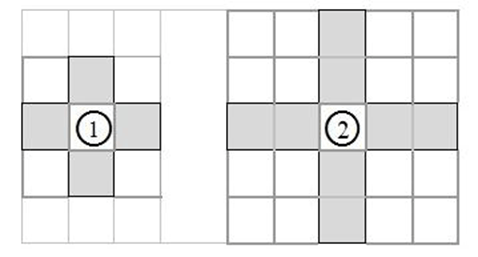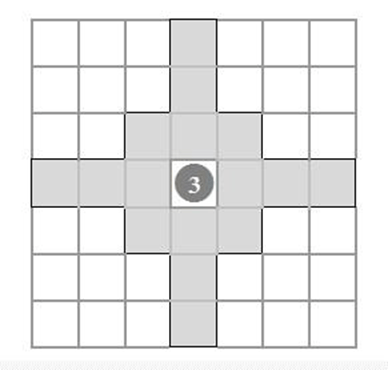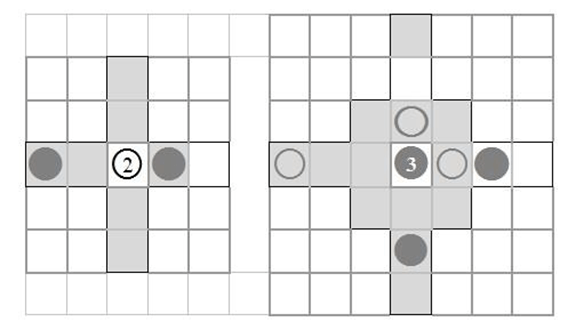
Claims of 1- and 2-high stacks are:
(© 2002, 2005 Barrie Evans)
1. Play starts with an empty playing area.
2. Players take it in turns to play. A play consists of either:
(a) playing a piece on an unoccupied square - see rule 5
(b) attacking and playing a piece on a square occupied by another player - see rule 6
(c) placing a second piece on a square occupied by one of your pieces.
A square is occupied by the player who last played on it. Note that after a piece or stack has been successfully attacked, a second piece can be added to it on a subsequent turn according to rule 2(c), since it is newly occupied by one of your pieces. (Note also that the rules do not stop a stack being reoccupied. Tracking strengths will become challenging if there are a number of stacks greater than 2-high.)
3. 1- or 2-high stacks make claims in orthogonal directions. 3-high and higher stacks make claims in orthogonal and diagonal directions.

Claims of 1- and 2-high stacks are:

Claims of a 3-high stack are:
Similarly, a 4-high stack exerts claims over 4 squares orthogonally and 2 squares diagonally.

(Blocking)
4. A stack has no claim on a square at which it would normally have a claim according to rule 3, in an orthogonal direction, if all intervening squares are occupied.
5. To place a piece on an unoccupied square your claims at that square (before the piece is laid) must at least equal the claims of other players at that square.
6. To place a piece on a square occupied by another player, your claims at that square (before the piece is laid) must at least equal the height of the stack being attacked plus the defending claims of that player at that square.
7. The game is finished when no player wishes or is able to make a further play.
8. A player scores a point at the end of the game:
(a) for each unoccupied square at which he or she has more claims than any other player (that is to say, where other players may no longer play)
(b) (optional) for each stack which he or she has 'jacked' and still occupies.
9. The player with the highest score wins.
The rules do allow in principle more than two players. It is suggested that, if this is done, to avoid 'ganging up', if a player is attacked more than once between plays by different players, he or she plays an additional play for each additional player attack.
Offline Website Builder